Ningaloo Coast – A World Heritage Area
The Ningaloo coast is a world heritage area and covers more than 600,000 hectares. You can snorkel or dive whichever you like or do both! You may even be lucky enough to swim alongside manta rays, turtles and whale sharks to name a few. The Ningaloo marine park extends 10 nautical miles seaward and encompasses over 5,000 square kilometres of ocean. With over 300 species of coral and 500 species of fish I’m sure you will thoroughly enjoy this area as much as we did.
Cape Range National Park – Bungarra Campground – $22/night unpowered plus a $15/car Entry Fee
In our minds there is nowhere as beautiful, rugged, adventurous or interesting as Cape Range National Park. If you are ever heading to the west, make sure Cape Range is on your list of places to visit.
Book early to secure a good site, we didn’t book that far in advance and although our site at Bungarra campground was great, there were others that are right on the beach. Bungarra has 4 sites and 1 site reserved as an overflow. Being a small campground has its advantages, especially when you are camping with friends as we were. We met up with our friends from Adelaide, Neville and Denise who were also travelling the west coast for the winter.
This campground as with all campgrounds here, have pit toilets and hard compacted large sites. You cannot have camp fires and they are all maintained by a camp host and our host was friendly, chatty and very helpful.
Our first 2 days here were so windy it was unbearable. So much so, that we didn’t set the camper up as we wouldn’t have been able to. Luckily our friends had a caravan so we could cook, chat and drink wine inside their van for the evenings. The set up in the back of car was perfect for these types of conditions. Once the big doors are down you can’t hear a thing and you are all lovely and warm.


The beach at Bungarra is a bit of a walk over some sand dunes. This beach really becomes interesting when the tide is out.

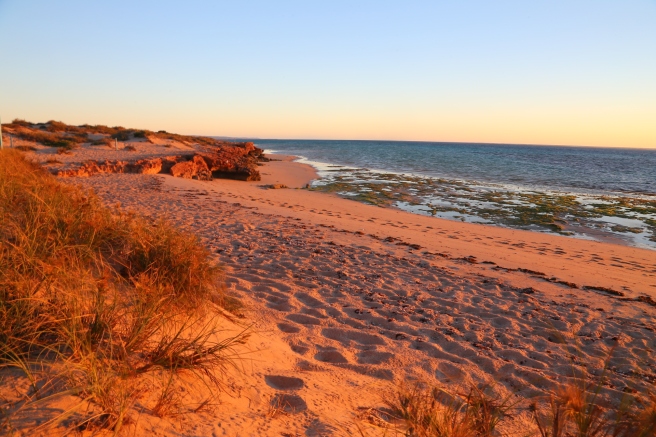

North Mandu would be one of our favourite places to snorkel and the campground is right on the beach. It is a small campground of 4 sites so perfect in all aspects but need to book in early to secure a site.
Turquoise Bay is as the name says the most brilliant turquoise colour and whitest sand imaginable. Turquoise Bay has the drift loop where you start snorkelling at one end and let the drift carry you across to the other end. Some days it was a really strong drift and others it was quite gentle. This beach is generally quite crowded as this is where the tour buses come to visit with the tourists. It is nice though to sit in the warm water and let the water pull you along.
Yardie Creek right is at the end or the beginning, depending on which end you start from. This is where the Yardie Creek flows through Yardie Creek Gorge out to sea. There is a 500m walking trail which meanders above the gorge. There is another walk into the gorge that continues along for about another 1.5km. The further you go the more difficult it becomes. The flora and fauna was really interesting and along the southern cliff face you will see loads of black footed rock wallabies lying around. We even managed to see some wedge tail eagles soaring above us. Yardie Creek is 38km from the Milyering Discovery centre.

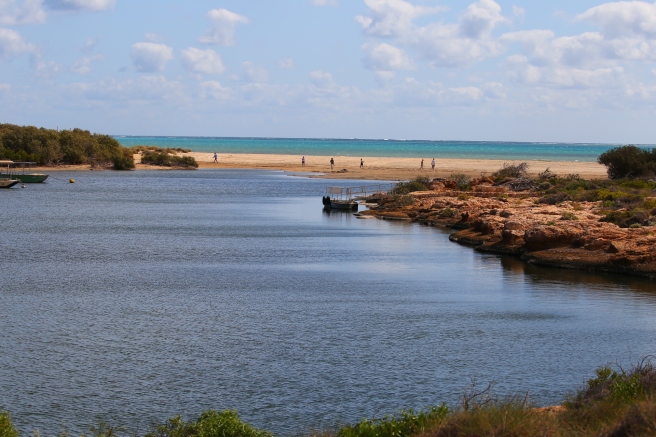



Lakeside was the best place for snorkelling, as not so many people go here and the fish and coral are in abundance. We even saw turtles and stingrays swimming close to shore.
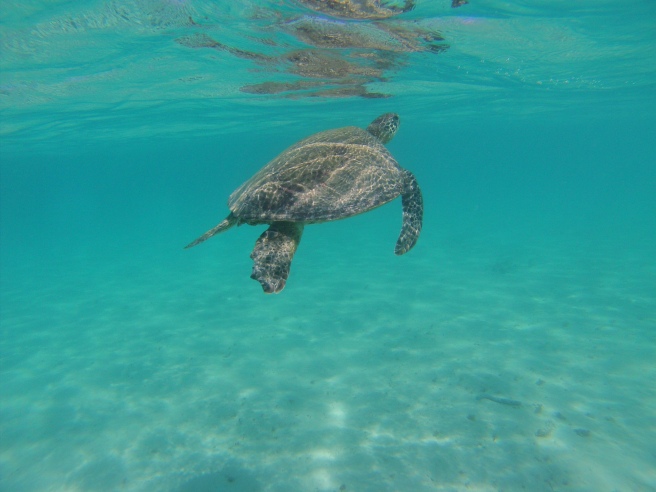
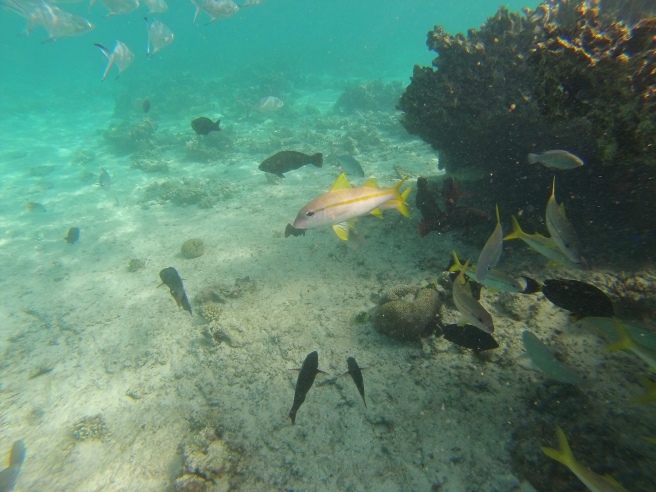

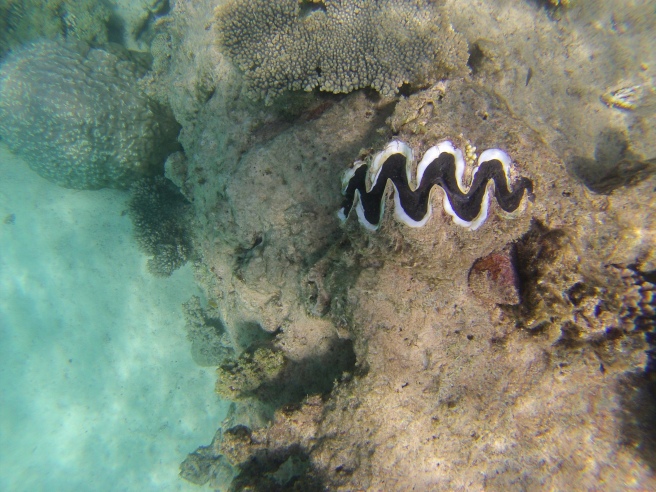
The Milyering Discovery Centre is where you pick up your free Wi-Fi and there is a water tap nearby for your untreated bore water.
The Oyster Stacks was another great place to snorkel and being very popular makes it very busy. Depending on what level the tide is at, it can be very difficult to get in and out of the water without getting pushed by the waves into the rocks.
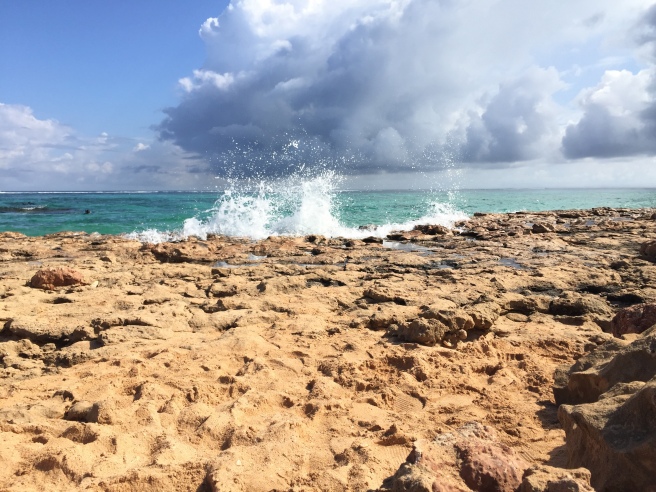
Sandy Bay was my most favourite place. It is a very large beach with beautiful turquoise water and white sand. What made this special is that the water is calm and shallow and there is a smallish reef where you can snorkel around and not that from the shoreline. I saw Box Fish and Angel Fish among many others.

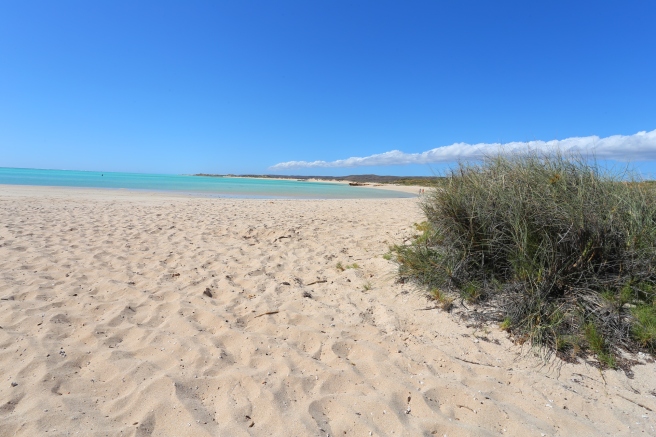
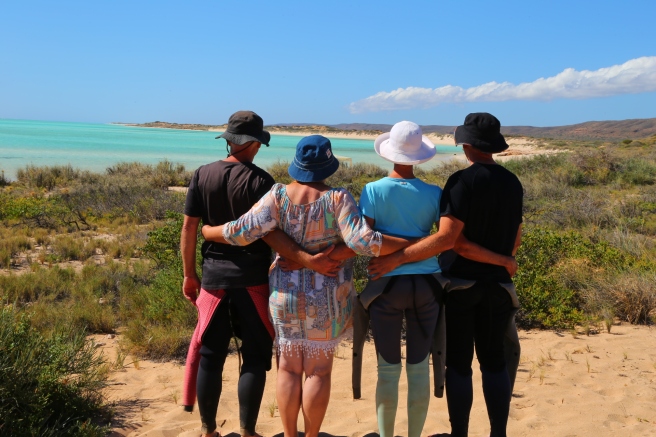
Exmouth – Ningaloo Caravan and Holiday Resort – $40/night unpowered
We checked back into the caravan park at Exmouth as Chris was booked with Dive Ningaloo again for another dive, this time at Blizard Ridge and Labyrnth.
Blizzard Ridge is a large rim of coral and reef found at approx. 1km out from the lighthouse at Exmouth. Around the rim there are lots of caves, crevices and overhangs.
Blizzard Ridge is located on the west side of the North West Cape. This dive site is approximately only 15 meters deep, but it’s an excellent site. He saw Olive Sea Snakes, Wobbegong and Pufferfish plus many more.
Labyrnth is also off lighthouse Bay and as with the other dive sites in this area it is shallow, with a maximum depth of 15 meters, offering lots of light on healthy coral and limestone formations, there is also a turtle cleaning station here. He was very lucky to have seen a humpback whale breach not very far from the boat as they were getting ready to go in. They saw green sea turtles, octopi and white tip reef sharks plus many other varieties of fish and gorgeous corals.
Once again he was thoroughly impressed with Dive Ningaloo for their professionalism.
Coral Bay – Ningaloo Coral Bay Resort Bayview – $46/night unpowered
The drinking water in Coral Bay is pumped from an underground artesian bore and placed into cooling tanks, desalinated and disinfected therefore, making it safe to drink.
There are two caravan parks in Coral Bay and as you would expect they are always busy. The caravan park we stayed in uses water direct from an Artesian Bore which is 830m deep and as such is extremely hot. It is unsuitable for drinking in its raw form and is very salty. The bathrooms are plumbed direct from the bore, they don’t have to use water heaters as the water is boiling hot. I found this water to be too drying on the skin when showering and I found that if you turn the hot water off and stand just under the cold water it gives you a nice rinse. They do have fresh water taps around the park where you can fill containers for free. There is a bulk water tap near the pool where you can top up your tanks. The first 20 litres of fresh water are included in your site fee, and then it’s $1 for each additional 10 litres. We didn’t use this as we made sure we had plenty when we left Exmouth.
We took a drive out to 5 Finger Reef. Firstly you must air down quite a bit as there are lot sand dunes to go through and some parts have very soft deep sand. This was so much fun making our way across to the ocean. There are lots of tight corners and as such there is a track in and a separate track out.
Five Finger Reef is super low-lying coral formation where you can drift snorkel. Be careful of your fins – the coral is very shallow!
It is the five fingers of parallel reef that give this place its name and they run from the beach to around 200 metres offshore. It is home to a huge array of colourful reef fish and other marine life.
They say the water around the reefs here is shallow, calm and brimming with marine life right close to shore. The day we were there it was certainly blowing a gale and the drift current was very strong. As only Chris and Neville were strong swimmers, we girls didn’t feel at all comfortable getting in. The boys said they found it quite difficult but the marine life was really good.

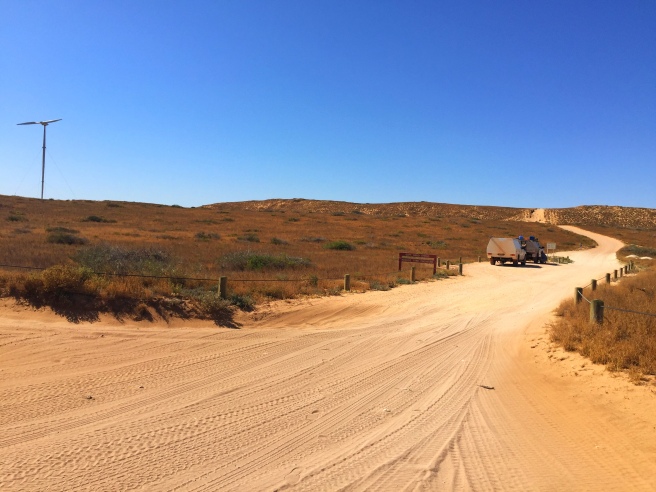

Coral Bay Township has everything you need with a little village supplied by a well-stocked supermarket, dive shop, hotel and wonderful bakery. Bills beach is across from the caravan park and is perfect for snorkelling every day. Every afternoon we saw a dolphin come into the shallows and jump around. There is something different every minute to see here. The drift section off to the left is great for a gentle snorkel back to the beach.
Ningaloo Reef Dive and Snorkel
Today was the day Chris ticked another dive off his bucket list. This time Photographer Peter Wandmaker came along so we bought some of his photos of the dive and snorkel day. The dive sites were Canyon and Ashos Gap which is famous for its shark cleaning station. This is where small cleaner wrasse fish swim into the mouths of the sharks and clean their teeth, just like going to the Dentist I guess. In between dives they swam with the majestic Manta Rays it was certainly something he will never forget.
Point Quobba Blowholes Camping Ground – $22/night unpowered
This is a council managed campground, they have a camp host who collects the fees, cleans the toilets and generally keeps everything in order. There are 2 x public long drop toilets near the lighthouse. The rules state if you are camping, you are not allowed to use the toilets and you must be self-sufficient. A small community of fisherman also live here. Basically you find anywhere you like to camp along the road which overlooks the ocean. Once again the wind here was not favourable and I would say almost gale force. We found a spot and ended up in a very deep spot of sand, anyway that was something we thought we would deal with in the morning. Setting ourselves up in the car this night was once again our only option.
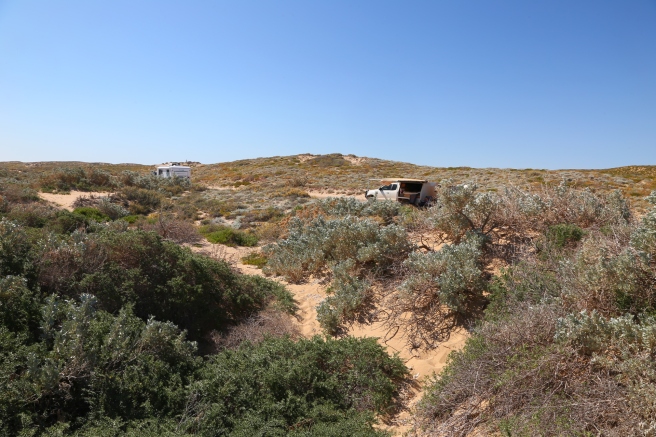
The Blowholes are located 75 kilometres south of Carnarvon on a bitumen road. Powerful ocean swells force water through sea caves and up out of narrow holes in the rocks, jets of water erupt into the air, sometimes up to a height of 20 metres, creating a spectacular sight. We timed our visit perfectly as the blowholes perform best when the tide is surging in for a high tide; the actual high tide is not the best time as most people would think.

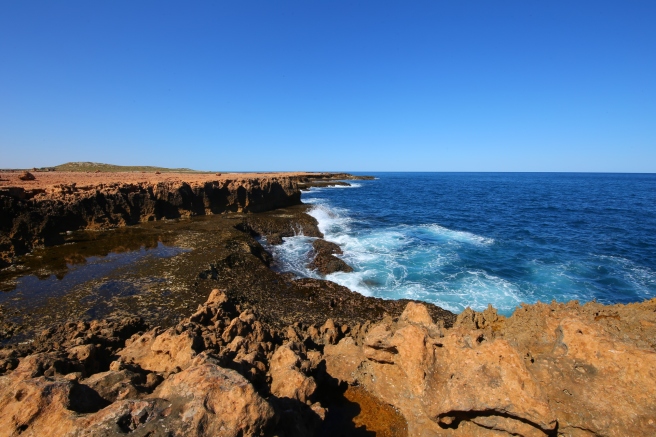
Just one kilometre south of the Blowholes is a calm coral-filled lagoon known as the ‘Aquarium’, with fish and shells in abundance and a white sandy beach. Unfortunately we couldn’t use this, as the ocean was so rough this day. However, I imagine on a calm day this would be a beautiful place to relax, swim and snorkel.
Carnarvon – Coral Coast Tourist Park – $39/night unpowered
Carnarvon is known for its lush horticultural landscape. It supplies 70% of Western Australia’s fresh produce. Did you know that Carnarvon was the first location in Australia to grow bananas? We were told to buy our fresh produce direct from the farmers as it is fresher. Basically all the fruit and veg in the supermarkets are from Carnarvon but it has to travel down to Perth and then make its way back up to Carnarvon. So makes sense to buy it direct from the farmer.
This was one of the very few caravan parks that actually give you access to a water tap in the unpowered section. There are many caravan parks here to choose from, Carnarvon is surprisingly a large town. We had heard on our way up that we should the visit the Space and Technology Centre which was a great insight to this era.
The Carnarvon Space and Technology Museum demonstrates the role Carnarvon played in the manned space program and in the Australian communications industry.
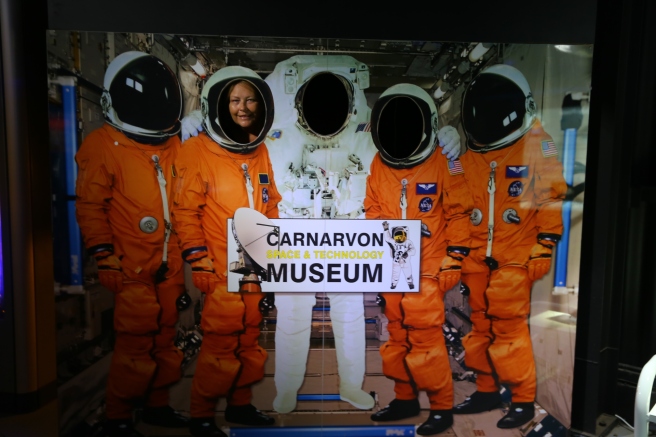

The museum focusses on two parts. The Carnarvon Tracking Station and the Overseas Telecommunications Centre; Satellite Earth Station, for which each station played separate roles in the early space industry. The station was built to support NASA’s Gemini, Apollo and Skylab programs. It was commissioned in 1964 and operated for 11 years.
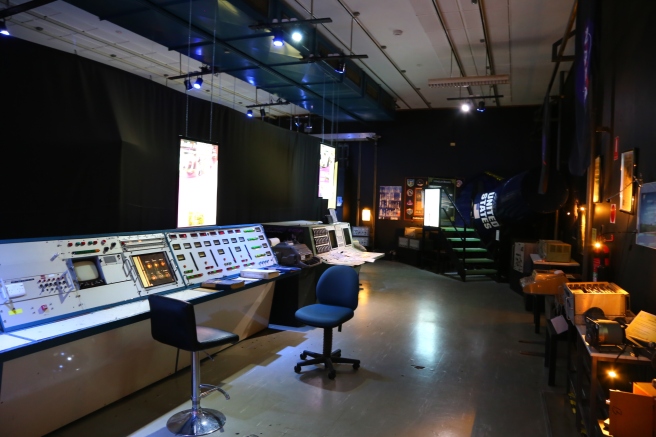

The train museum was also a great insight to the original town of Carnarvon. This museum houses the Kimberley Steam Train, which was brought down from Broome in the 1950’s. It was the last steam train to operate in the North West.
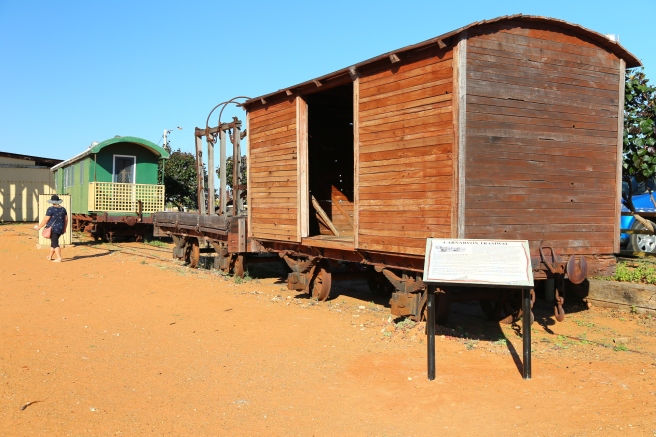



The one mile jetty was built around 1897 and had been built for wool and livestock produced in the region. It began to be exported to Fremantle and essential goods for the town were imported using state shipping. In 1904 the head of the jetty was added and in 1912 the jetty head was widened because of increasing traffic, including passengers. Carnarvon was the first port in Western Australia which loaded livestock on board ships for transport to markets. The jetty transport system on the tramway ceased in 1966 when state ships stopped calling. Road train transport commenced, and the jetty began to fall into disrepair until 1998 when the community banded together to save what is the longest jetty in the north of the state.
We took advantage of the fruit loop drive trail. A drive along North and South river roads, known as the ‘Fruit Loop’ reveals the heart of the horticultural industry. You will find seasonal fresh produce, the famous Sweeter Bananas, Seafood and locally made delicacies. We picked up some beautiful fruit and vegetables here at a great price. Well worth the drive out there.
Wooramel River Retreat – $26/night unpowered
Located 120km’s south of Carnarvon and 2km’s off the highway. The campground is located right on the banks of the Wooramel River. The property occupies an area of 1,340 square kilometres with 60 kilometres of coastline frontage to the Indian Ocean and backs onto the Shark Bay world heritage area. The Wooramel River is an upside down river running on the surface only 2-3 times a year for a couple of weeks at a time. The artesian bore found on the property sends water 240m to the surface and maintains a constant temperature of about 33C and a high mineral content, you can sit in the purpose built spas and relax. This place is awesome with friendly camp hosts and each site is well away from the other. There are flushing toilets, showers, camp kitchen, and communal fire pit and entertainment area.




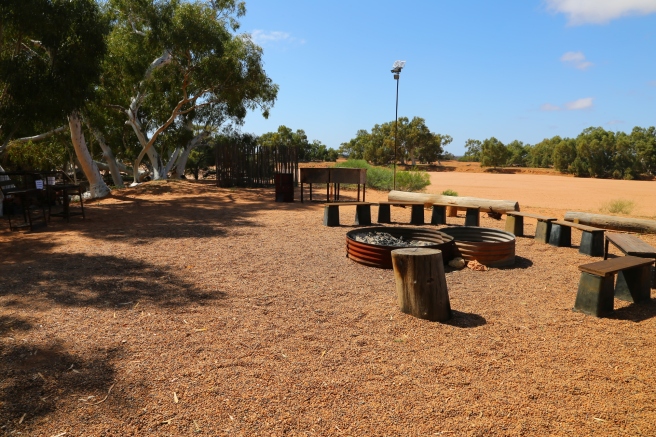

Galena Bridge – Free Camp
After we left Wooramel the roadside became really interesting with lots of Sand hills covered in bright red sand. After Billabong Roadhouse you start to see many wildflowers along the roadside.
There are 2 sides to the campground which are located either side of the Murchison River, which surprisingly had water in it. We found this to be a very peaceful place to spend the evening. The campground has a long drop toilet, dump point and rubbish bins.




Kalbarri – Anchorage Caravan Park – $38/night unpowered
It was a short drive to Kalbarri about 80km. We decided to visit some sites at the Kalbarri National Park before making our way to the caravan park. As there are no camping facilities in the National Park you have no choice and have to stay in a caravan park. All roads in the park are sealed making it very accessible to everyone.
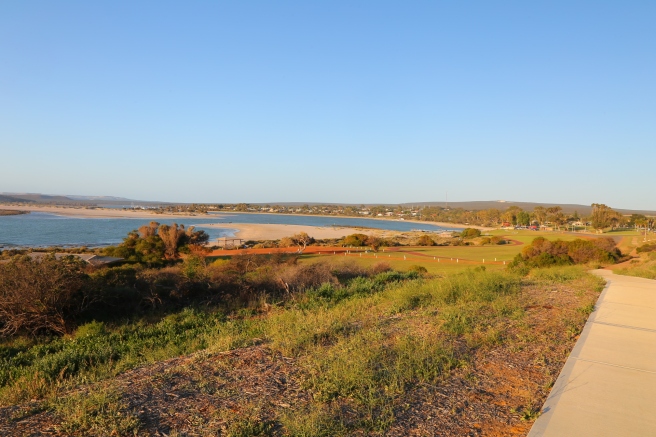
Kalbarri National Park surrounds the lower reaches of the Murchison River, which has over time cut an 80 kilometre gorge through the red and white banded sandstone to create formations.
First stop is the Ross Graham-Hawks Head Entry Station where you need to pay your $15/car entry fee into the honesty box. Make sure you keep your receipt to show proof to the ranger when you want to enter the other parts of the park.
Ross Graham Lookout – Class 3, 700m return
Ross Graham Lookout provides excellent views of the Murchison River Gorge, there is a picnic shelter and toilet facilities. The 700 meter walk along the walk trail allows you to explore the shady banks and tranquil pools of the Murchison River below.

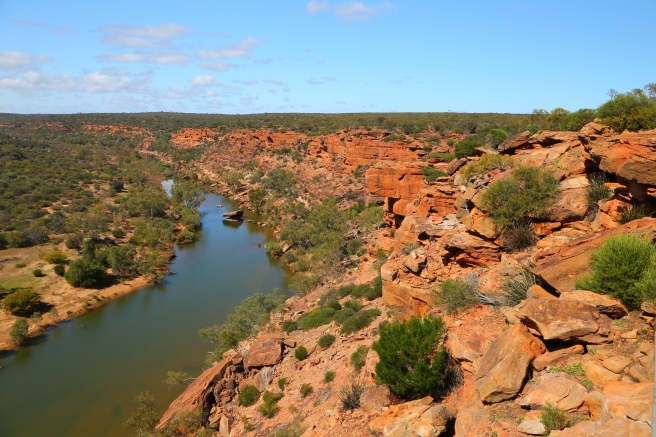

Hawks Head – Class 1, 200m return
A short accessible path at Hawks Head leads to a lookout providing expansive views over the Murchison River Gorge. There is a sheltered picnic area and toilet facilities.
Both of these areas had wildflowers along the paved paths and were in abundance with such pretty colours. The views to the Murchison River are amazing and we found this park extremely well cared for.
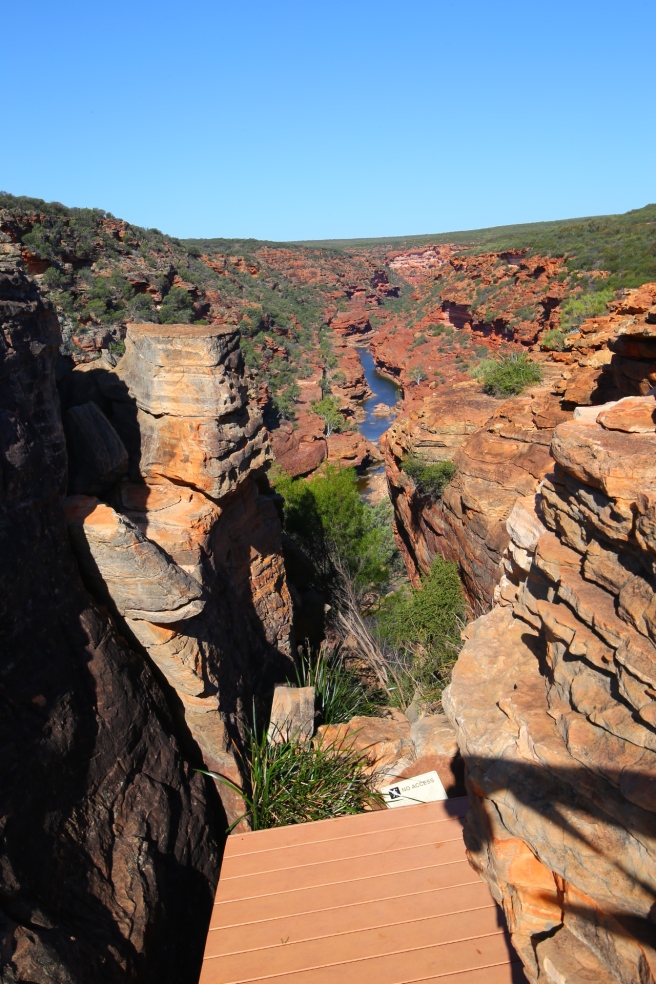

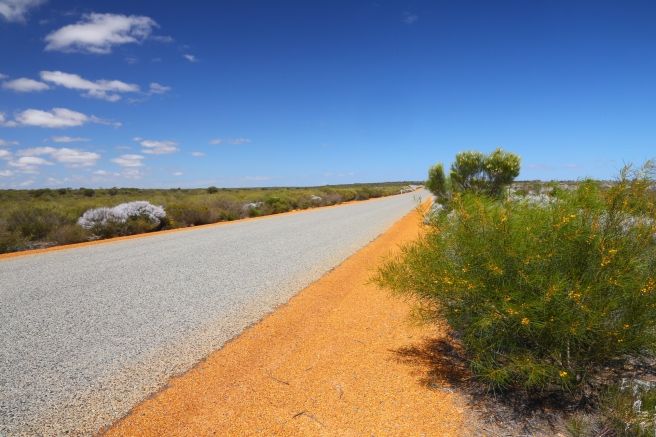

West Loop Lookout, the Loop, Z Bend and Natures Window
These are the closest to the Kalbarri Township. Word of warning, if you are towing you either have to unhitch and leave your rig at the car park or do what we did and unhitch where you decide to stay for the night.
Z Bend Lookout, Class 3, 1.2km return
This was quite an easy walk and once at the lookout you are rewarded with magnificent views down to the river. You can continue on a further 2.6km return walk down to the river. It is a class 4 and is quite demanding.
West Loop Lookout was closed while we were there.
The Loop and Natures Window, Class 3, 800m return
This is relatively easy and allows for magnificent views of the Murchison River. After you leave the loop it is pretty much downhill all the way. Just keep reminding yourself what goes down must come up. Yep it was a killer coming back up but totally worth it. The Natures Window is a rock arch that frames the Murchison River upstream. Lots of little wildflowers everywhere you walk making it so beautiful, make sure you get that all important photo hanging off the cliff!
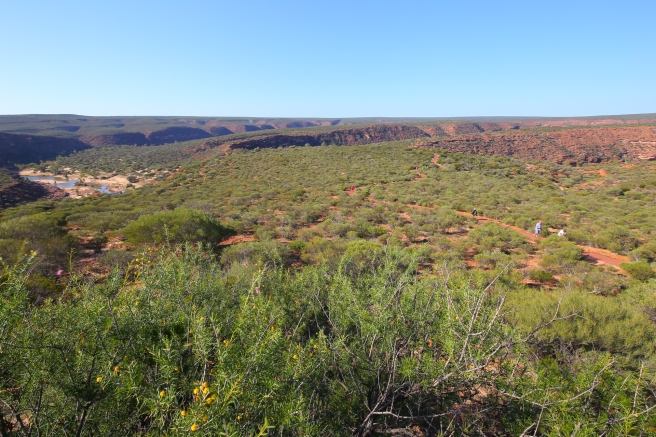 Kalbarri National Park
Kalbarri National Park




From the Natures Window there is another hike called the loop trail which is class 4, 8km loop. We spoke to some people on their way back from the walk and they said it was brilliant but exhausting and quite demanding.
Geraldton – Sunset Beach Caravan Park – $38.50 powered
Geraldton is a very interesting place and to be honest I really had no idea what to expect. I was however, extremely surprised. It has a mix of city and rural living and is a big city with an even bigger heart. It has quite a diverse economy and has industries including mining, aquaculture, manufacturing, construction, farming, retail and of course tourism. It has a population of over 40,000 people so as you can imagine it is really spread out. The beaches are crystal clean and the temperature was quite warm when we were there.
We took a walk along the foreshore, it boasts barbecues, walking/cycling tracks, picnic areas, playgrounds shaded areas, exercise facilities and a water park to name a few. We walked from the marina to the esplanade. The facilities here are world class and there is something for everyone.
 Geraldton Western Australia
Geraldton Western Australia

St Francis Xavier Cathedral
Was designed by Monsignor John Hawkes and took 22 years to build. It is in the heart of the city and was fascinating to walk through.
 St Francis Xavier Cathedral, Geraldton Western Australia
St Francis Xavier Cathedral, Geraldton Western Australia


HMAS Sydney II Memorial
This memorial would without a doubt be the nation’s premier site for honouring the 645 crew who were lost in battle on 19 November 1941. This resulted in Australia’s worst maritime disaster. The fate of HMAS SYDNEY II and her crew remained a mystery until 2008 while using high-tech Sonar equipment, specialised teams located the wreck on the floor of the Indian Ocean at a depth of 2468 meters. The final resting place was approximately 300km off the Western Australian coast near Carnarvon.
 HMAS Sydney II Memorial, Geraldton Western Australia
HMAS Sydney II Memorial, Geraldton Western Australia


The bronze statue of a woman staring out to sea waiting for her loved ones to return symbolises all families and their anguish. While I found the whole memorial moving and emotional, the statue of the waiting woman was very emotional to me. The unimaginable pain displayed on her face still haunts me, I felt like I wanted to hug her. Ironically in 2008 when the Sydney’s final resting place was located, it was found that the ‘Waiting Woman’, set in place in 2001, was peering out to sea directly in line with the location of the wreck. Behind her is a dome with 7 pillars representing the states and territories and on top are 645 stainless steel gulls to represent the men who lost their lives that fateful day.

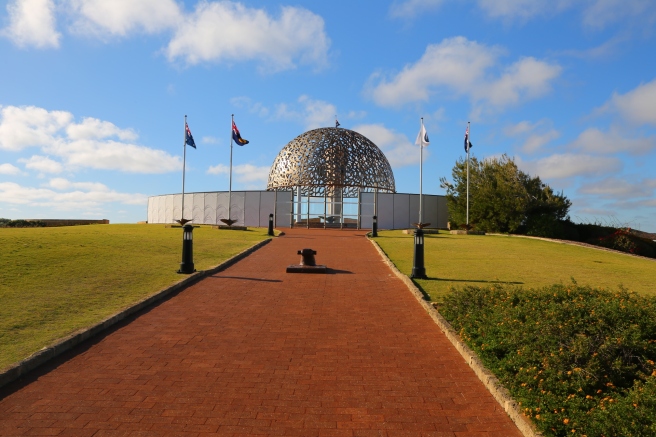

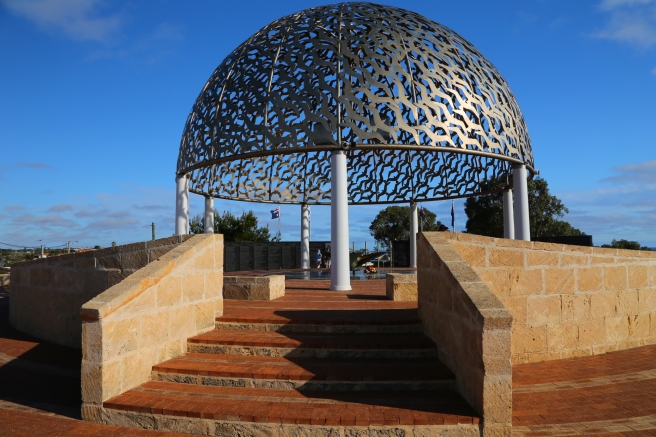


Leeman
We are now travelling on Highway number 60 Indian Ocean Drive. Leeman is 261km south of Perth and I would describe Leeman as a beautiful sleepy, quiet, quaint village. Apparently it is also ideal for fishing. We found a nice little place to pull up at Ti-Tree Point near the lookout. This lookout provides 360 degree views of Leeman and Bay Beach. This area has well maintained picnic facilities complete with toilets, playground, shaded picnic table and chairs all with views of the ocean. The town has a little store with food supplies and a long jetty. We were even treated with seeing an Osprey eating fish on top of telegraph poles.

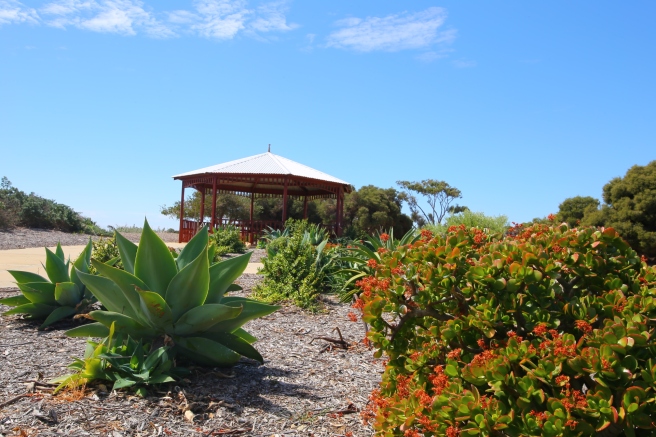



Lancelin – Experience Lancelin Holiday Park – $27.50/night unpowered
Lancelin was set back from the beach and protected by the sand dunes. It seems a quaint little town as all the towns are along this stretch. However, this was the strangest caravan park I have ever stayed in, set close to the beach and quite a large caravan park. The front section is where the powered sites looking reasonably nice and very close together, this section had the nicest views of the ocean. Further back is what seems to be a residential area with shacks and then further behind that is a small section in what they call “unpowered” now if we were staying at a roadside stop, I’d have been really happy with this. This area is a thin, narrow strip on thick grass under many low lying trees. Lancelin offers many sand dunes with activities such as sand boarding and 4×4 driving. The town is serviced with a general store, supermarket, cafes and roadhouse.
Nambung National Park – The Pinnacles – $15/car entry fee
Thousands of huge limestone pillars rise from a stark landscape of yellow sand to form one of Australia’s most intriguing landscapes.
If you are towing you will have to unhitch and leave your rig in the parking bay and from there you can drive your car along the tracks through the Pinnacles. Alternatively, you can do what we did and leave your car and rig in the car park and walk through. Personally I would walk again as you do see more. Parking bays are also provided at various points along the one-way drive to allow you to stop and explore.
In places, the pinnacles reach up to 3.5m tall. Some are jagged, sharp-edged columns, rising to a point, while others resemble tombstones. Many pinnacles display cross-bedding structures, where the angle of deposition of the sand changes. Apparently this indicates that the dune from which the limestone bed was formed was originally laid down by the wind.
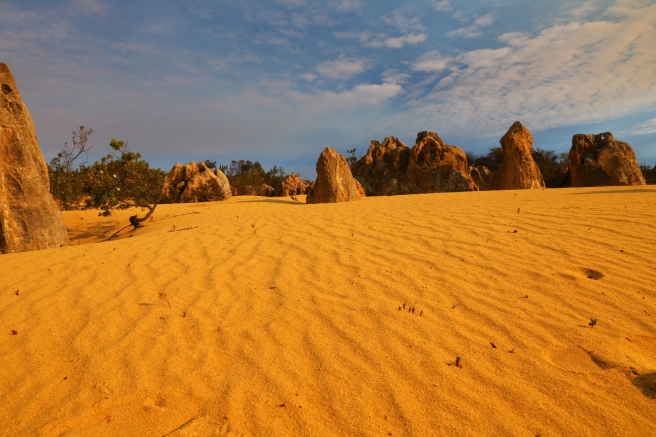
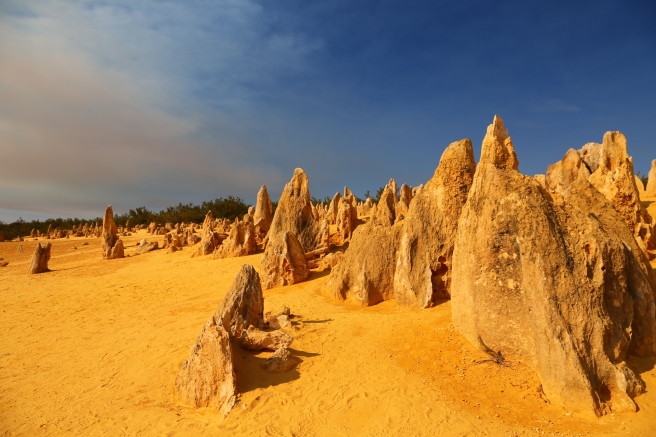

Continue reading “Cape Range National Park to The Pinnacles in Nambung National Park”










